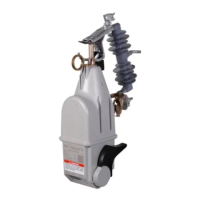64 S&C Instruction Sheet 461-509
Analog Input Points Configuration
This window contains conguration parameters for analog input points. Mapping these
points will make them available in SCADA. The window is initiated by clicking on the
Analog Input button. See Figure 62.
Figure 62. The Analog Input Points configuration screen.
Status Point: These point numbers represent what the SCADA system will see in
response to a static or event data request or an unsolicited event response.
Code Description: These are the point codes representing specic analog inputs that
may be assigned to individual SCADA point numbers for TripSaverII reclosers paired
with a communications gateway. A full list of code-description denitions is found in
S&C Instruction Sheet 461-560, “TripSaver® II Communications Gateway: DNP
Points List and Implementation.” Code descriptions are dened by selecting the
Code Description eld in line with the respective Status Point eld. A drop-down
dialog box will appear with code denitions for all TripSaverII reclosers paired with
the communications gateway. When a code denition has been chosen, select the
Check Mark icon to nalize it. Removal of a code selection can be performed by selecting
the blank row in the pull-down menu and clicking on the check mark. This will result in
the eld being displayed as empty. Finally, click on the Save button.
Event Class: This is the DNP event class assigned to this point. Specify Class 1, Class 2,
or Class 3, or choose the No Event option to turn off event-data reporting for this point.
Scaling: A scaling factor is used for the analog input data to match the analog input
requirements of the SCADA system. The original raw analog input data will be multi-
plied by the specied scaling factor prior to delivery to the SCADA master. If the Fixed
Deadband option is enabled for an analog input setpoint, the scaling factor will be
applied before the Fixed Deadband limits are checked.
Conguring the Communications Gateway

